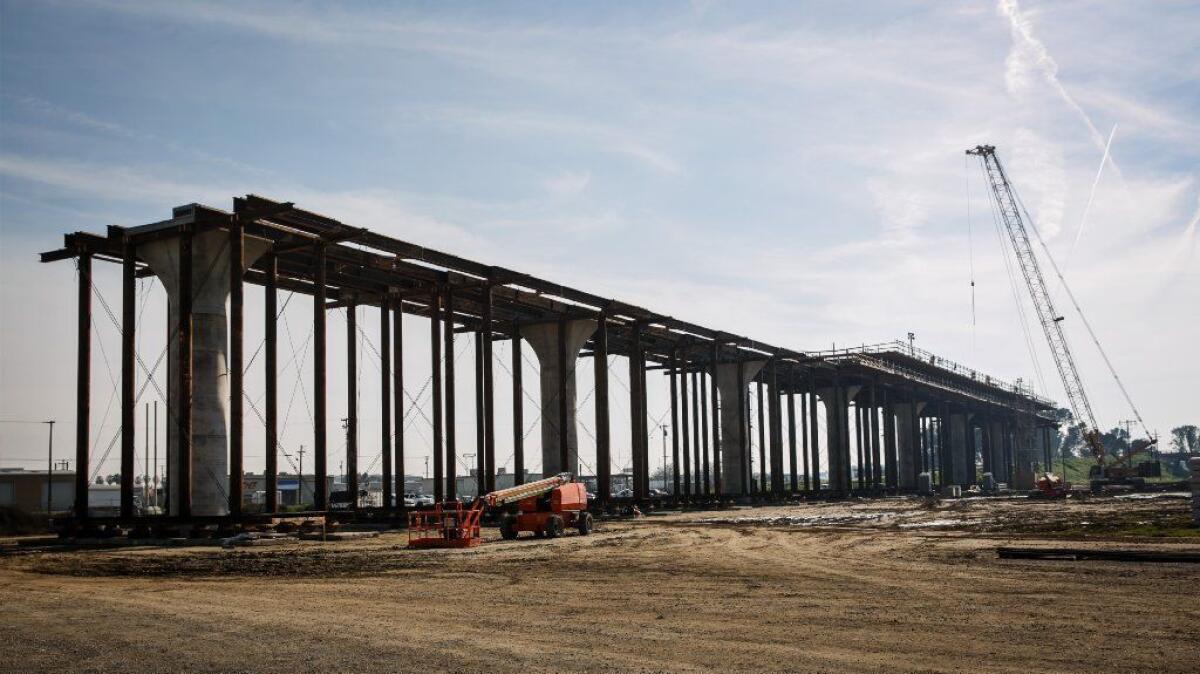California bullet train costs up $1.7 billion for Central Valley segment

- Share via
The California bullet train project, already mired by major delays and rising costs, is facing $1.7 billion in cost overruns on a 119-mile segment currently under construction through the Central Valley, a 27% jump over the original estimate, according to new documents
The increase reflects difficulties officials have encountered over the last five years, including buying land, moving underground utilities and negotiating agreements with freight railroads.
The Central Valley construction and planning is now projected to cost $8 billion, based on a quarterly report — known as the funding contribution plan — that was issued in June but not made public until this month. Work on the track, originally scheduled to be finished this year, is about seven years behind schedule.
The latest overruns could have larger consequences. If the reasons for the Central Valley increase also affect other parts of the Los Angeles-to-San Francisco project, then it could drive up the price for the entire $64-billion system by billions of dollars.
Critics long have forecast that the final tab could top $100 billion. But supporters of the bullet train — the nation’s largest infrastructure project — reject those assertions, saying the rail line will become a cornerstone of the state’s transportation system and that such cost increases should be taken in stride.
The California High-Speed Rail Authority said it has been transparent about the cost pressures, reporting to a joint budget committee in the Legislature in December that the tab for the Central Valley segment had hit $7.8 billion. That report, however, included signals, electrical systems and a maintenance facility that were not part of the Central Valley construction program’s original scope, which was priced at $6.3 billion.
“We put our best estimates forward,” rail authority spokeswoman Lisa Marie Alley said . “There are going to be cost increases, but there could be cost decreases.”
The funding contribution plan was posted on the authority’s website after a Bay Area watchdog group, Californians Advocating Responsible Rail Design, filed a public records act request.
Officials have disputed outside estimates that indicate the project’s price tag is growing — including one in December by the Federal Railroad Administration that cited a cost of $9.5 billion to $10 billion. In 2015, the authority’s main consultant, WSP, also had said in an internal assessment that costs were rising.
The rising total could challenge California to find new sources of revenue to complete the project even as Gov. Jerry Brown, its biggest proponent, serves out his last 15 months in office.
The large number of changes that have been made to the scope of project since its inception make cost comparisons problematic. The rail authority added 2.7 miles of track and structures from Madera to Merced, but reduced 8 miles near Shafter that included a long viaduct through the city.
It also had to increase safety barriers that would prevent freight trains from crashing into bullet trains where the tracks come within 102 feet of each other, adding tens of millions of dollars in costs.
Alley noted that the cost increases have not all come at once, and that the rail authority has and will continue to properly report them.
“We are looking at the scope, schedule and budget for the 2018 business plan, which will be out in February,” she said.
The cost pressures have been building from a variety of sources: property values are increasing; the number of parcels needed to complete the project has grown; officials faced more work than expected with utilities; and other so-called third-party and railroad negotiations were difficult.
“A lot has happened over the years,” Alley said. “We are always mitigating and looking for ways to reduce costs.”
But those costs could go even higher.
One of the state’s major contractor teams — led by the Spanish construction giant Dragados — is seeking hundreds of millions of dollars in additional payments, rail authority officials said during a recent public meeting. Dragados was selected in December 2014 to build a 65-mile section south of Fresno for $1.23 billion. So far, it does not appear that construction has started.
According to an update this month, the rail authority is looking for ways to contain costs through, among other things, instituting better management controls, reducing the scope of the project and planning “early minimal operations” once the rail system is up and running.
How that translates into actual changes to the project is not yet clear.
One concrete example to lower costs cited by the documents is, rather than building multimillion-dollar safety barriers, by running trains slower in urban areas.
Such a change would affect travel times.
Under the 2008 bond act that voters approved to help fund the bullet train, the system has to be designed to get between Los Angeles and San Francisco in 2 hours and 40 minutes. A number of experts doubt the project can meet the requirement once it is built, given the many political compromises that already will mean reduced speeds in various parts of the state.
“If we reduce peak speeds, we’ll have to make up the time somewhere else,” Alley said.
Follow me on Twitter @rvartabedian
More to Read
Sign up for Essential California
The most important California stories and recommendations in your inbox every morning.
You may occasionally receive promotional content from the Los Angeles Times.














